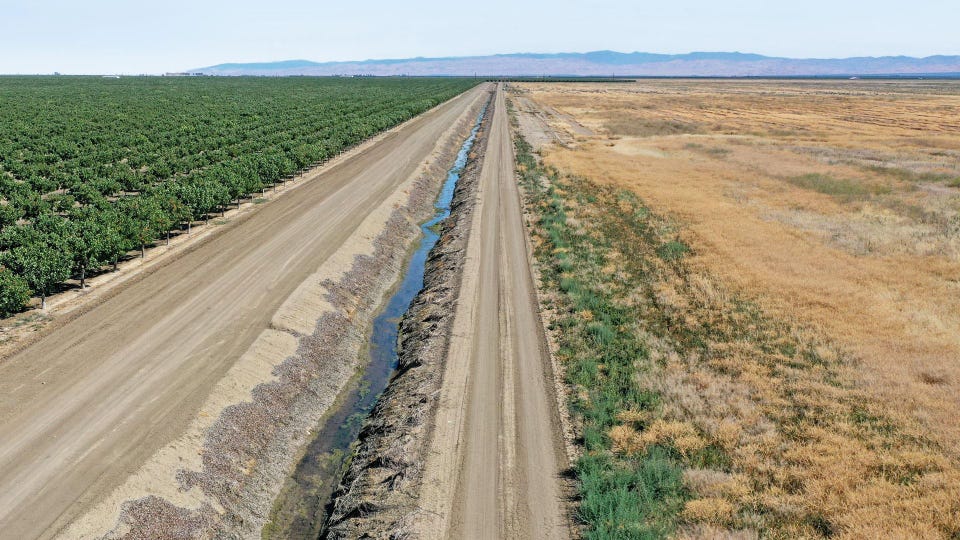N ature has a way of telling people when their wells are running dry. In California’s Central Valley, where 40% of the fresh fruits, nuts and other produce consumed across America are grown, an increasing number of residents are getting the warning sign. “The sand came through our washing machine and through the regular faucets,” said a man who lives in the tiny Fresno County town of Riverdale who asked that Forbes not use his name.
He said his well kept pumping up dry dirt, until it pumped nothing. “It’s been very challenging, not being able to provide for my family a normal thing that a lot of folks in large metropolitan areas take for granted. ” In just the past month, as California temperatures soared during a drought so severe some experts say it hasn’t been this parched in 1,200 years, about 250 wells, mostly in the state’s bread basket, have gone dry.
They’re part of the more than 1,100 California wells that have dried up so far this year, a 60% increase from 2021. While that may not seem like a lot, given that California has 274,000 wells , it’s an ominous sign and a personal tragedy for the one million Californians who struggle for clean water. In many cases, it also pits hugely important agricultural producers, who rely on underground water for their crops, against their own workers, who need it to drink.
“Water levels are dropping,” said Daisy Gonzalez, the community solutions coordinator at the Central Valley-based Community Water Center. “There’s nothing natural about it. The fact that we’re in an agricultural region, that makes these private wells really vulnerable.
The drought becomes the icing on top. ” California’s Central Valley is responsible for a quarter of the nation’s food and 8% of total U. S.
agricultural output. Farmers are gearing up for harvest, which every year makes late summer and early fall the peak period for water use. During times of drought, there’s no rain to replenish surface water, so agricultural giants, which include California’s dairy industry, pistachio and almond growers and tomato farmers, often end up pumping more groundwater.
Add a heat wave that saw temperatures in Sacramento, at the northern end of the state’s fertile region, hitting the most triple-digit temperatures in a row since 1988, and you have the makings of a water emergency. The ones who bear the burden of water shortages are the most vulnerable people in society, said Jose Pablo Ortiz Partida, a senior water and climate scientist at the Union of Concerned Scientists. Most of the residents affected in the Central Valley are farmworkers, many of whom are immigrants or lack documentation of citizenship.
They spend hours in what can be 90-plus-degree weather picking nuts or pomegranates. “For weeks, people have been losing their water access,” Ortiz Partida told Forbes. “There’s deep injustice that these communities experience.
” Yet, in the Central Valley, dry wells are only part of the problem. For example, the water available to residents of Caruthers, California, is often contaminated so badly with arsenic, nitrates, pesticides and other cancer-causing contaminants that it’s undrinkable. People there, as well as in the small towns of Cantua Creek, Matheny and Tranquility elsewhere in the Central Valley, often overpay for water that’s trucked in.
Unincorporated towns like those can’t negotiate the same rates that big cities like San Francisco or Los Angeles can. “A lot of these families don’t have air conditioners in their homes,” Ortiz Partida told Forbes . “They have a bad night with heat and even if they start working early, it’s extremely hot already by 9 a.
m. There aren’t many shaded areas in the orchards. Some people have to carry seven bottles of water just to make it through the day.
” While some residents struggle, crops get the water they need. The Central Valley has about 17% of the country’s irrigated land. More than 250 different crops, worth around $20 billion per year, use that irrigation.
The most common are cereal grains, hay, cotton, tomatoes, vegetables, citrus, tree fruits, nuts, grapes for eating and grapes for wine. About 20% of America’s total groundwater demand is supplied from pumping Central Valley aquifers, making it the second-most-pumped aquifer system in the U. S.
to the Ogallala in the Midwest, according to the U. S. Geological Survey.
The Ogallala Aquifer is also running out of water . California has $750 million allocated to support the current drought — including funds to emergency programs that install water storage tanks at homes where wells have stopped working. But recently, tank orders are backlogged for weeks due to supply chain delays.
The Central Valley, which includes the San Joaquin and Sacramento valleys, probably won’t see more precipitation until the winter, and climate change has already taken a serious toll on California’s water storage. Every major reservoir for the state is currently holding a fraction of its historic average amount of water. The threats aren’t going away.
It’s projected that in the San Joaquin Valley alone, between roughly 4,000 and 12,000 drinking water wells will go partly or completely dry by 2040, impacting as many as 127,000 people, according to a 2020 study by The Water Foundation. Big farming corporations have deeper pockets to fight climate change’s harshest impacts. When it comes to accessing water, these firms have deeper wells than a community or an individual household, and also have more money to spend on electricity to pump water from lower depths.
“It has enormous impact on the hands that grow the food that we eat,” Char Miller, a professor of environmental analysis and history at Pomona College and the author of Natural Consequences: Intimate Essays for A Planet In Peril , told Forbes . “Part of the history of water in California has always been about the big dog grabbing the largest share and doing whatever they can to maintain it. That’s a huge injustice.
”.
From: forbes
URL: https://www.forbes.com/sites/chloesorvino/2022/09/22/california-farms-pump-water-to-feed-crops-amid-extreme-heat-and-drought-but-residents-wells-are-running-dry/



